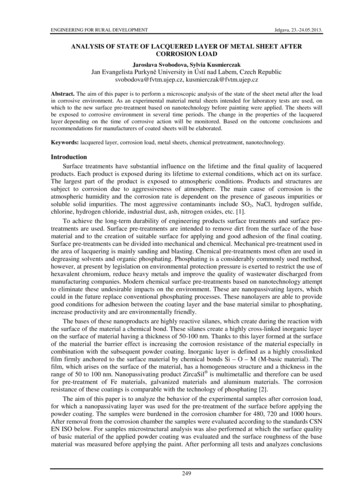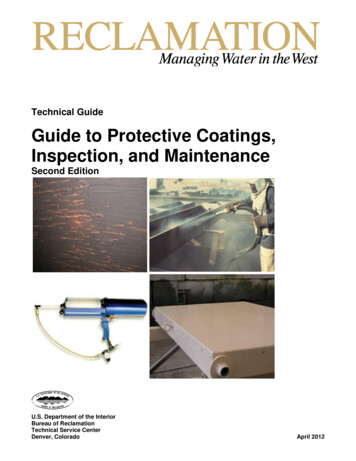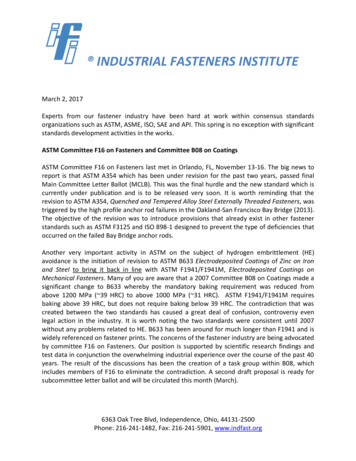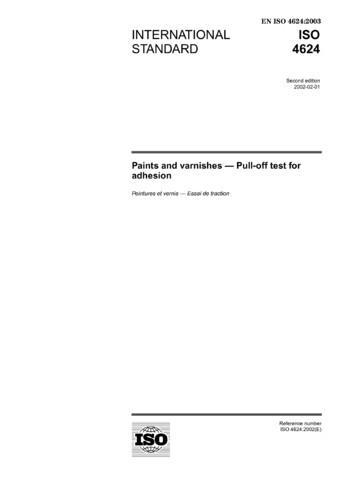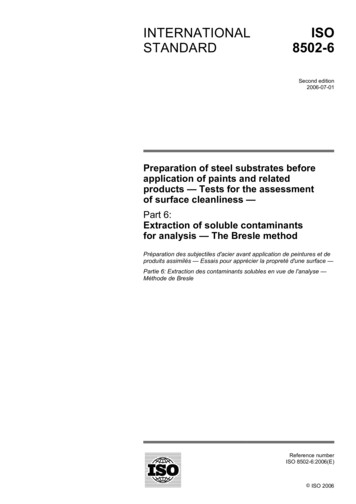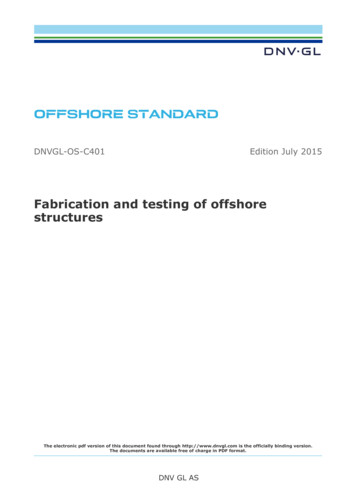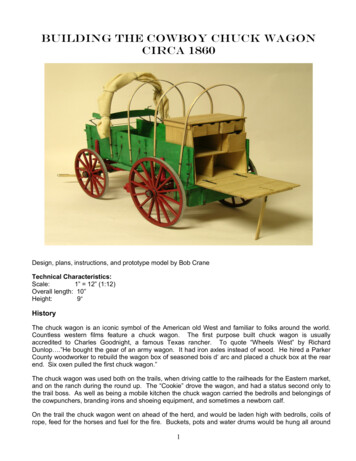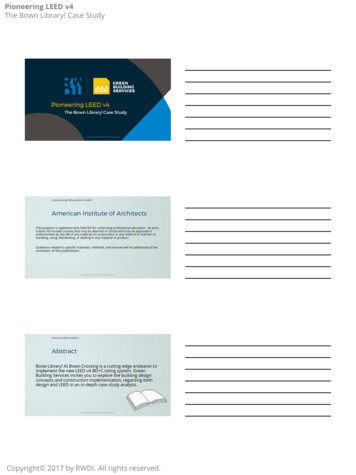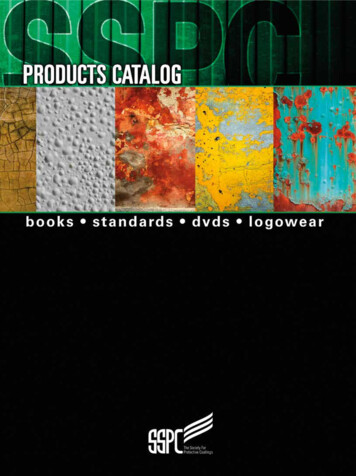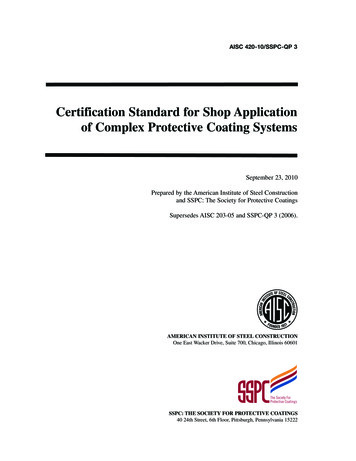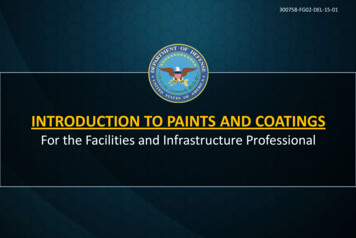
Transcription
300758-FG02-DEL-15-01INTRODUCTION TO PAINTS AND COATINGSFor the Facilities and Infrastructure Professional
Paints & Coatings for DOD F&I Department of Defense (DOD) manages 555,000 structures Buildings, structures, pipelines, pavement and port facilities Broad range of environmental severity zones (desert tomarine) Millions of Square Feet of painted steel, wood, aluminum &concrete. Costs over 100 Million per year to maintain the exterior ofDOD’s building Paints & Coatings are addressed by numerous UFGS andUFC 3-190-06*hover over the underlined items for more details
Introduction to Paints & CoatingsPaint can be defined as a mixture or dispersion of opaque pigments or powders in aliquid or vehicle.Coatings include other materials that can be considered paint-like in their use such asvarnishes and inorganic binders.Modern classifications of paints: Architectural/Trade Sales - commonly recognized latex and alkyd paints sold inretail stores. Industrial/Maintenance – may include anti-corrosive primers, machinery andindustrial enamels and other products that require more specialized applicationequipment. Some trade sales type paints are also used in Industrial situations (i.e.High Performance Architectural Coatings). Specialty – are generally very specific in their use, application and resistanceproperties such as plastics coatings, coil coatings, and resistive coatings.
Paints & Coatings Review fundamentals of coatings by focusing on: Types of coatingsSurface preparationApplication of coatingsInspectionDefects and failures
Mechanisms of Corrosion Control by Coatings Barrier protection Chemical inhibitors Inhibitive Pigments Galvanic (cathodic) protection Zinc Galvanizing Metallizing*hover over the underlined items for more details
What’s in the Can?Basic components of a paint or coatinginclude: Binders – also known as the resin,polymer or vehicle. Pigments – include the coloring andfilling materials. Solvents – are the volatile thinners ordiluents that evaporate. Additives – are materials that areadded to modify or improve specificproperties related to processing,appearance or performance.
Generic Coating Types AlkydsBituminous coatingsCoal tar epoxiesEpoxiesFluoropolymersInorganic zinc-rich coatingsLacquersMoisture curing polyurethanes(MCU)Organic zinc-rich coatingsPhenolic and phenolic epoxycoatings
Generic Coating Types (cont.) PolyasparticPolyesters/vinyl estersPolysiloxanePolysulfides modified with novolacepoxy resinPolyureaPowder coatingsSiliconesThermal spray metallicsWater-borne acrylics*hover over the photos for more details
Important Factors in Coating Selection Mission/operational needsExterior weatheringWater, fuel, solvent, or chemical resistanceAbrasion, heat, or mildew resistanceAppearanceDrying timeEase of application and maintenance
When Specifying a Coating Application Consider: Severity of environmentSurface preparationAccess to workDrying timeApplicator skillsScaffoldingSafety and environmentalrequirements
Surface PreparationThe life of any coating system is directly impacted by the quality ofthe prepared surface. The better the surface preparation, thelonger the life of the coating system Treatment of Surface IrregularitiesPre-cleaning to remove surface contaminantsCleaning surfaces to desired levelsProducing a surface profile (texture)*hover over the underlined items for more details
Surface Contaminants Causing Early Coating Deterioration RustMill scaleGrease and oilDirt and dustSoluble saltsWaterPaint chalkLoose, cracked, orpeeling paint*hover over the photos for more details
SSPC Standards for Mechanical CleaningSSPC Standard SP 2 Hand tool cleaning SP 3 Power tool cleaning SP 15 Commercial grade power tool cleaning SP 11 Power tool cleaning to bare metal SP 10 Abrasive blast to near-white metal SP 5 Abrasive blast to white metalExtent of Removal of Contaminants Removes all loose mill scale, rust, and paint Removes all loose mill scale, rust, and paint Removes all visible contaminants for stains up to33%; minimum 1 mil profile* Removes all visible contaminants; minimum 1 milprofile* Removes all visible comtaminants except forstaining limited to no more than 5 percent Removes all visible contaminanants*SP 15 and 11 allow some contamination to remain in the bottom of pits
Methods of Application: General Factors Suitability for the particular coating and structuralcomponents Desired appearance Speed, ease, and economics of application method Simplicity of equipment/necessary applicator skills Safety/environmental requirements Weather Transfer Efficiency Coverage Rates
Methods of Application Manual (brush or roller) High-volume, low-pressure(HVLP) spray Airless spray Plural component spray Conventional air spray
QualityQuality Assurance (QA) Planned and systematic actions to provide confidence that asystem will perform satisfactorilyQuality Control (QC) The portion of QA that ensures that materials, methods,workmanship, and the final product meet specifiedrequirements
Purposes of the Specification To obtain a specific desired productTo assure quality materials and workmanshipTo make sure the work is completed on timeTo avoid delays and disputesTo obtain minimum or reasonable costsTo avoid costly change orders and claimsTo meet all safety, environmental, and legal requirements
Paints and Coatings: Criteria and ToolsArchitectural Painting Specification Decision Treehttp://www.wbdg.org/tools/apsdt.php?c 5Unified FacilityGuide SpecUFGS 09 90 00Paints & ovedProductsListUFC 3-190-06 Protective Coatings and Paintshttp://www.wbdg.org/ccb/DOD/UFC/ufc 3 190 06.pdfUFGS http://www.wbdg.org/ccb/browse cat.php?c 3UFGS 09 90 00 Paints and CoatingsUFGS 09 96 00 High-Performance CoatingsUFGS 09 96 59 High-Build Glaze CoatingsUFGS 09 97 01.00 10 Metallizing: Hydraulic StructuresUFGS 09 97 02 Painting: Hydraulic StructuresUFGS 09 97 13.00 40 Steel CoatingsUFGS 09 97 13.15 Epoxy/Fluoropolyurethane Interior Coating of Steel Petroleum Fuel TanksUFGS 09 97 13.16 Interior Coating of Welded Steel Water TanksUFGS 09 97 13.17 Three Coat Epoxy Interior Coating of Welded Steel Petroleum Fuel TanksUFGS 09 97 13.25 Maintenance, Repair, and Coating of Tall Antenna TowersUFGS 09 97 13.26 Coating of Steel Waterfront StructuresUFGS 09 97 13.27 Exterior Coating of Steel StructuresUFGS 09 97 13.28 Protection of Buried Steel Piping and Steel Bulkhead Tie RodsUFGS 09 97 23.13 Interior Lining For Concrete Storage Tanks (For Petroleum Fuels)UFGS 09 97 23.16 Linseed Oil Protection of Concrete SurfacesUFGS 09 97 23 Metallic Type Conductive/Spark Resistant Concrete Floor FinishUFGS 09 97 30 Preparation of Historic Wood and Metal Surfaces for Painting
Common Inspection Hold Points or Check Points Pre-Cleaning SSPC-SP 1 Surface Preparation SSPC/NACE blast standards Primer, Intermediate and Top Coat Application SSPC-PA 1 Dry Film Thickness SSPC-PA 2 Cure Solvent rub test, organic coatings ASTM D5402 Post-Cure Film Integrity Holiday detection NACE SP 0188
Factors Accelerating Deterioration Structural designSubstrate propertiesMaterials deficienciesSurface preparation deficienciesApplication deficienciesCuring deficiencies*hover over the underlined items for more details
DeficienciesSurface Preparation Deficiencies Incompatible coatingsLow quality materialError in manufactureExpired shelf lifeWrong coating for the wrong serviceSurface Preparation Deficiencies Insufficient cleaning level Contaminated surfaces Profile too low or too high
Application Deficiencies Equipment inadequate or not functioning properlyAmbient conditions outside recommended rangeMixing, thinning, or straining inadequateFilm thickness too low or highInadequate induction time, expired pot life and recoatwindow Unskilled applicator
Coating Incompatibilities Solvent in topcoat attacks undercoat Coating solvent causes bleeding of bituminousproduct Rigid topcoat applied over flexible undercoat Water-borne product does not adhere to smoothundercoat
Paints & Coatings in F&I Address coatings requirements early in the design process Understand the environmental stressors Get help with the Specification Selection of PaintSurface PrepApplicationInspection Adopt a QA/QC program throughout the Build Process Create a Sustainment Program that includes Monitoringand Maintenance Know where to get help from Service and DOD resources
Where to go for helpCorrDefense.orgThomas - F& I Coating Vignette25
This training is provided by the Office of theSecretary Defense (OSD), Corrosion Policy andOversight Office (CPO)
References Corrosion Prevention and Control: A Program ManagementGuide for Selecting Materials, Spiral 2 (2nd Edition),AMMTIAC, Sept 2006 Master Painters Institute (MPI) NACE SSPC FICES Report, July 2013
Introduction to Paints & Coatings Paint can be defined as a mixture or dispersion of opaque pigments or powders in a liquid or vehicle. Coatings include other materials that can be considered paint-like in their use such as varnishes and inorganic binders. Modern classifications of paints: Architectural/Trade S
